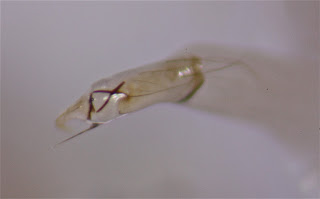Seven North American caddisfly families are collectively known as "netspinners," or "fixed retreat makers" (vs. the "portable case makers"). Only three of these families live in our streams: the "common netspinners," the "fingernet netspinners," and the "trumpetnet netspinners". Since we've already discussed "common netspinners" (family: Hydropsychidae) in an earlier entry (1/5/11), the focus here will be on the fingernets and the trumpetnets. (Note: apparently two other netspinner families are found in other parts of Virginia -- Dipseudopsidae and Psychomyiidae -- but I don't think they've been seen, so far at least, around here.
Fingernets (family: Philopotamidae) are called "fingernets" quite simply because they make a net out of silk that's a long thin tube, that sort of looks like a finger. This they attach to the bottom of a rock, open end facing upstream. They live at the bottom end of the net and let their food come to them, every so often "cleaning" the net. If you lift up rocks to see their nets, you're out of luck. The net immediately collapses into a small pile of sandy, silky goo (in which you might see something wiggle!).
The fingernet caddis is easily recognized even by novice samplers, mainly because of its color. It's orange, or yellow, or pale yellow, and the head is always burnt orange. It also sports a "black collar;" there's a black line that crosses the top of the body right behind the pronotum. We find them in almost all of our streams -- some more than others -- and at almost any time of the year. But with a family tolerance value of 3.0, they can be scarce or non-existent in our very poor streams.
There are three fingernet genera, and we find all three in our streams. Without any question, the genus we find in almost all cases is the genus Chimarra. This is the most tolerant of the three, assigned, by some, a TV of 2.8. The distinguishing feature of this genus is readily visible with a microscope, and if the larva is big enough, it can be seen with the naked eye (it's visible in the photo at the top of the page).
Chimarra larvae have a prominent notch in the frontoclypeal apotome (i.e. in the leading edge of the head). Take a good look at this photo.
Here the membranous labrum (which is "T" shaped) projects between the mandibles, and behind that is the leading edge of the top of the head. The "notch" could hardly be clearer.
The second genus, Dolophilodes, is less tolerant of stream impairment (with a TV of 1), and to be honest I've only seen this larva in two of our local streams. One is the Whippoorwill Branch of the Mechums River; the other, the Rapidan River. The frontoclypeal apotome in this case does not have a notch -- but it is not completely even or symmetrical. I hope this is clear from the picture below: the edge of the head bulges slightly on the left side (from the point of view of the larva). (Note that the mandibles are closed in this photo.)
Chimarra and Dolophilodes larvae, I think, also differ slightly in appearance: the Chimarra head is more elongate and narrow when seen from the side; the Dolophilodes head more rounded. (As in the photos below.)
The third fingernet genus, Wormaldia, is one that I've seen only once -- and I don't have a picture to show you. It is the most intolerant of impairment (TV of 0.4) and thus will only be found in very clean streams. We found one last fall at one of the StreamWatch reference sites, and it is, as it should be, being kept in the StreamWatch reference collection. The distinguishing mark? The frontoclypeal apotome (leading edge of the head) is completely symmetrical -- no bulges, no notches.
The trumpetnet caddis (family: Polycentropodidae) makes a net in the shape of a trumpet -- or maybe a funnel -- i.e. it's wide at one end and narrow at the other. This is attached to the base of a rock and funnels bits of food to the larva at the base of the net. This is a caddis we do not see too often. And, it is very difficult to distinguish this one in the field. Unlike the "common netspinner," it has no frilly gills on the belly, and unlike the "fingernet caddis," it is not yellow or orange -- it tends to be tan in color. When in doubt, samplers should preserve this kind of larva for lab identification. Here is a photo of a specimen that's been preserved.
This family has two distinguishing features. 1) The head is almost always covered with grayish dots (these are known as "muscle scars"). And 2) the fore-trochantin -- sort of the "shoulder blade" of the first arm/leg is pointed and sticking forward, sort of like the edge of a knife. Here is a close-up of that particular feature.
One last item of interest on the "trumpet net" caddis -- there is one genus that is "opportunistic" in its feeding habits. While it relies mostly on bits of organic matter that flow into its net, if it senses movement of a small nymph or larva moving over its net, it will rush out (well, not sure "rush" is the right word to use!) and eat it for lunch. This is the genus Polycentropus, and this is precisely the genus we have in our streams. How do we discover this genus? Look for the "X": there is a very clear "X" on the dorsal plate of the anal proleg (obviously, you can only see this through a microscope.)








No comments:
Post a Comment